Choosing the Best Driveway Crack Sealants
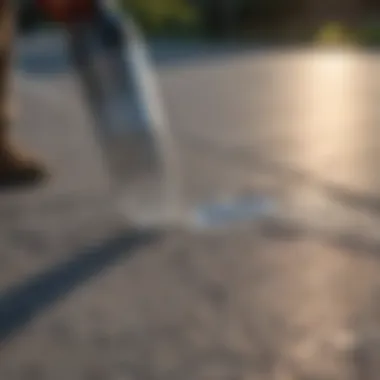
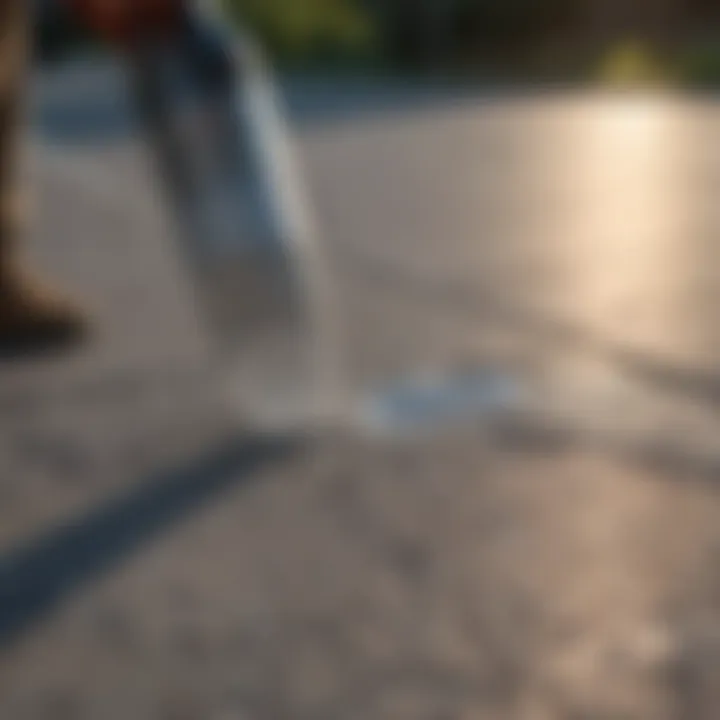
Intro
Every homeowner knows that a driveway is more than just a place to park a car; it’s an essential part of the curb appeal of any property. Driveway crack sealants play a crucial role in preserving that appeal while extending the lifespan of this exposed surface. Given the fact that driveways bear the brunt of weight from vehicles and are constantly exposed to the elements, it is important to address any cracks that appear swiftly and effectively.
The topic of driveway crack sealants involves understanding the various types available on the market and how they function. Homeowners have an array of choices ranging from asphalt-based sealants to rubberized products. Each type comes with its unique set of advantages and disadvantages. Therefore, selecting the right one hinges on a thorough understanding of the specifics, such as the existing condition of the driveway, climate considerations, and the intended use of the surface.
Moreover, choosing the appropriate sealant is not just about aesthetics – it’s about durability too. A timely application can prevent water from seeping into cracks and causing more significant damage. Thus, the importance of educating oneself about these materials cannot be understated. Faulty or messy maintenance can lead to spending more time and money in the long run.
In this article, we will navigate through all facets of selecting and applying driveway crack sealants, providing a firm grounding for homeowners making decisions in this area. From understanding common challenges and pitfalls to offering solid product recommendations and step-by-step guides, we aim to equip readers with the knowledge necessary to keep their driveways in tip-top shape.
Foreword to Driveway Protection
Maintaining a driveway is often an overlooked aspect of homeownership, yet it's fundamental in preserving the integrity and aesthetic appeal of one's property. A well-maintained driveway not only enhances curb appeal but also serves as the first line of defense against environmental elements that could cause significant damage over time. Effective driveway protection is about more than just appearance; it plays a critical role in ensuring safety, avoiding costly repairs, and upholding property value.
When considering driveway sealants, understanding their importance cannot be stressed enough. Sealants act as a barrier against moisture, oils, and UV rays, extending the life of the driveway while minimizing the risk of cracks and other damages. They create a waterproof and protective coating that prevents water from infiltrating the concrete or asphalt, which can lead to structural failures. Time and again it’s shown that a proactive approach in sealing driveways proves much more economical in the long run compared to dealing with significant repairs.
Importance of Sealants in Driveway Maintenance
Sealants are pivotal in driveway maintenance, akin to sunscreen on skin. They shield the surfaces from harmful effects stemming from weather fluctuations, chemical spills, and general wear and tear. As many homeowners may reflect, installation of quality sealant can mean the difference between a driveway that lasts a decade versus one that deteriorates after just a few years.
Some key benefits of using sealants include:
- Protection Against Moisture: Sealants form a barrier against rain, which can penetrate cracks and cause significant damage.
- Prevention of Cracks: Sealants can fill small cracks and prevent them from worsening into larger fissures.
- Aesthetic Improvement: A sealant can restore and enhance the original color, giving it a fresh, new appearance.
- Cost Efficiency: Regular application of sealants can significantly reduce future repair expenses.
“A stitch in time saves nine.”— this age-old proverb rings particularly true when one thinks about driveway maintenance. Taking preventative measures with sealants leads to fewer headaches down the road; it’s all about staying ahead of the game.
Common Causes of Driveway Cracks
Understanding what causes driveway cracks is crucial for choosing the right sealants and ensuring effective maintenance. Like many other parts of a home, driveways are subjected to a range of stressors that can lead to damage if not properly mitigated.
Some common causes of driveway cracks include:
- Weather Extremes: Harsh winters and scorching summers can cause materials to expand and contract, leading to cracks.
- Improper Drainage: If water doesn’t drain properly, it can pool and seep into the driveway, causing underlying damage.
- Heavy Loads: Vehicles that exceed weight limits or frequent heavy machinery can stress the driveway's surface.
- Tree Roots: As trees grow, their roots can push against and crack the surface of the driveway.
Awareness of these factors can empower homeowners to take preventive actions, such as regular inspections or quick sealing when minor cracks appear. Informing oneself creates a solid foundation for future maintenance efforts.
Types of Driveway Crack Sealants
When it comes to maintaining the integrity and appearance of your driveway, selecting the right sealant can be a game changer. The type of sealant you choose plays a crucial role in the effectiveness of the repair, how long it lasts, and how well it withstands various conditions. With so many options on the market, understanding the distinctions between them can empower homeowners to make informed decisions.
It's not just about filling a crack; it’s about enhancing your driveway’s durability and appearance. Each type of crack sealant serves its own purpose and caters to specific needs, whether it's for minor fissures or extensive damage. Therefore, grasping the nuances of the different types will certainly pay off in the long run.
Liquid Sealants
Liquid sealants are often considered the go-to choice for many homeowners due to their ease of use and flexible application. These sealants typically come in a ready-to-use bottle, making them accessible for DIY enthusiasts. One primary advantage is that liquid sealants can easily fill in small cracks and provide a smooth finish.
However, it’s important to acknowledge some limitations. These sealants may not adhere well to larger cracks or those that have seen significant movement. Therefore, before applying, ensure that the cracks are clean and dry to achieve the best results.
Advantages of Liquid Sealants:
- User-Friendly: Ideal for DIY projects as they are easy to apply.
- Versatility: Can be used on driveways made of multiple materials.
- Cost-Effective: Generally lower priced compared to more complex options.
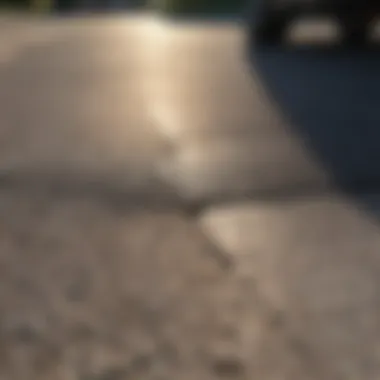
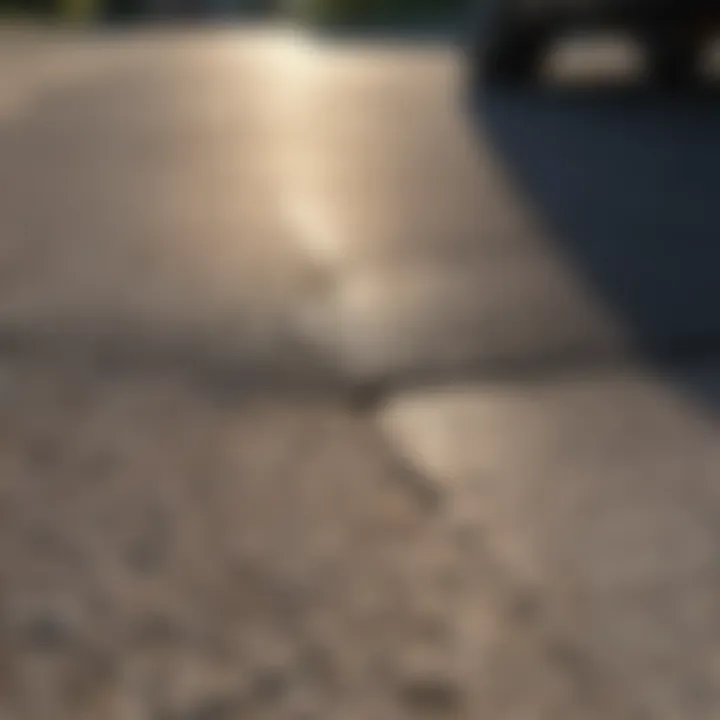
Rubberized Crack Fillers
Rubberized crack fillers are designed specifically to cater to larger fissures, offering superior flexibility and durability. These sealants contain rubber as a primary component, making them resilient against various temperatures and weather conditions.
Every homeowner knows that driveways bear the brunt of heavy vehicles and direct sunlight. The ability of rubberized fillers to expand and contract makes them particularly effective against such stresses. Unlike liquid sealants, they bond well even in significant gaps, providing lasting protection.
Key Features of Rubberized Fillers:
- Enhanced Flexibility: Withstands temperature variations.
- Better Adhesion: Suitable for larger cracks.
- Durability: Lasts longer in adverse weather conditions.
Asphalt-Based Sealants
Asphalt-based sealants offer a different blend of ingredients, providing a reliable layer of protection against wear and tear. These fillers are highly adhesive and work well on asphalt driveways, making them favored for those who prioritize sturdiness.
The application process for asphalt-based products is slightly more involved, often requiring surface preparation and perhaps even a primer. But once applied, these sealants can make a world of difference. They form a robust layer that can significantly prolong your driveway’s lifespan, especially in areas where heavy traffic is expected.
Benefits of Asphalt-Based Sealants:
- Strong Bond: Excellent adhesion properties.
- Long-Lasting: Stands up against heavy usage.
- Protects from UV Damage: Helps prevent further deterioration.
Cold-Pour versus Hot-Pour Sealants
The debate between cold-pour and hot-pour sealants is one that many homeowners encounter when looking to repair driveway cracks. Each method has its own set of advantages and considerations.
Cold-pour sealants are, as the name suggests, applied at ambient temperatures. This method is generally easier since it doesn't require special equipment to heat the material. However, it may not offer the same strength as hot-pour sealants, which are melted and then applied while still hot, creating a cohesive bond as they cool.
For those in warmer climates or with concrete driveways, hot-pour options may be more applicable due to their resilience and durability. But do remember, applying hot-pour sealants typically demands a bit more expertise and preparation.
Comparison of Cold-Pour and Hot-Pour Sealants:
- Cold-Pour:
- Hot-Pour:
- Easiest for DIYers.
- Doesn't require special equipment.
- Stronger and more durable.
- Requires careful application.
Understanding these types of crack sealants not only outlines their specific purposes but also helps homeowners choose the best option tailored to their driveway’s material and condition. Armed with this knowledge, making a decision becomes a straightforward process.
Criteria for Selecting Sealants
When it comes to keeping your driveway in tip-top shape, the right sealant can be a game changer. The criteria for selecting sealants is crucial for ensuring the longevity and effectiveness of your driveway repairs. Choosing wisely means considering several specific elements that can impact your project and help you maintain the beauty and functionality of your outdoor space.
Climate Considerations
One of the foremost factors to think about is your local climate. Different regions experience varying weather conditions that can affect sealant performance. For instance, if you're in a place that sees extreme heat, look for sealants designed to withstand high temperatures without breaking down. Conversely, in colder climates, you want products that remain flexible even when the mercury drops. Moisture levels also play a big role: in areas with heavy rains, sealants that are water-resistant or waterproof are essential. Choosing a sealant that suits your environment can mean the difference between success and a wasted afternoon.
Driveway Material Compatibility
Just as important is the compatibility of the sealant with your driveway material. A concrete driveway demands different treatment compared to asphalt. For example, some products might adhere better to asphalt, while others are specially formulated for concrete surfaces. If you apply an incompatible sealant, you risk ineffective coverage that can contribute to more cracks instead of fixing existing ones. Always check the product label to see whether it mentions compatibility specifics to avoid future headaches.
Durability and Longevity
Durability and longevity are also where the rubber meets the road. No one wants to redo their sealant job every couple of years. Some sealants are designed for short-term fixes, while others might last for a decade or longer. It’s wise to read user reviews and check the manufacturer’s claims on durability. Products that give you a good warranty often indicate confidence in their longevity. Remember, investing a little more at the outset can save you plenty of time and hassle down the road.
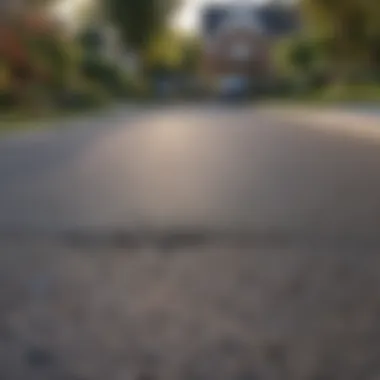
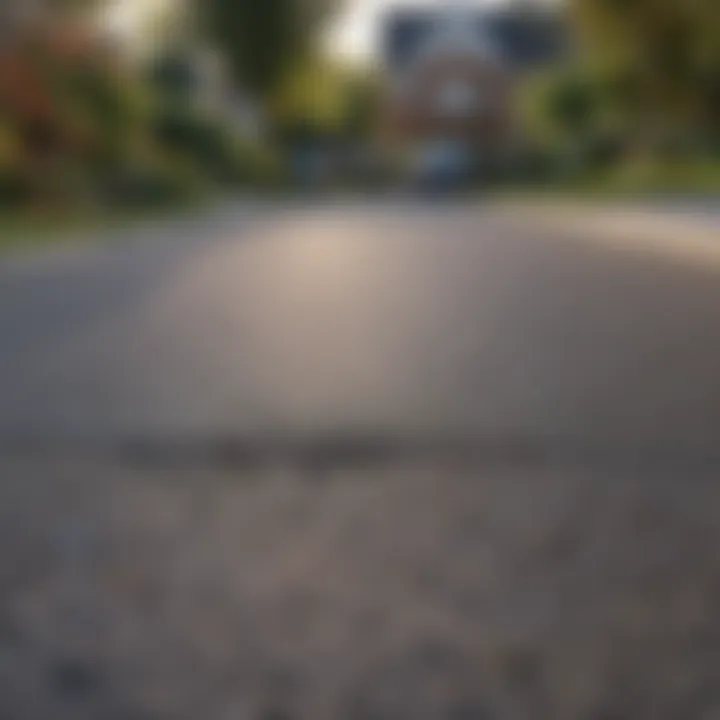
Ease of Application
Don’t overlook how easy or complicated the application process is. For many homeowners, particularly those who may not consider themselves handy, a straightforward application can make a world of difference. Some sealants offer ready-to-use formulations that simply require a pour and spread method, while others may require several steps—like mixing or surface preparation. If the setup looks daunting, you might want to consider finding one that’s user-friendly.
"The easier the application, the more likely you'll tackle the job yourself."
Using products that come with clear instructions and easily accessible tools can demystify the process.
In summary, when it comes to selecting sealants, always ponder these factors: how climate impacts performance, whether your chosen sealant is fit for your driveway's material, its expected durability, and how easy it is to apply. Navigating through these criteria will set you up for success as you embark on maintaining your driveway. Keep these points in mind; they’ll lead to a well-kept driveway that remains sturdy and stylish for years to come.
How to Apply Driveway Crack Sealants
Applying driveway crack sealants is a critical step in preserving the integrity of your driveway. A well-executed application not only enhances the appearance but extends the lifespan of your asphalt or concrete driveway. Without proper application, even the best sealants can fail, leading to more significant issues down the line. Thus, grasping the techniques and preparation involved is vital for homeowners seeking to protect their investment.
Preparation of the Driveway Surface
Before diving into application, preparing the surface is step one. You wouldn't build a house on a shaky foundation, right? The same logic applies here.
- Clean the Surface: Begin by removing debris, dirt, and old sealant. A power washer or a stiff broom will do wonders. Pay special attention to the cracks themselves, as any leftover dust can hinder adhesion.
- Inspect for Damage: While cleaning, inspect for any larger issues, like alligator cracking or potholes. If things look worse for wear, you may need to address those before applying sealant.
- Drying: Make sure that the surface is completely dry. Any moisture trapped underneath the sealant could lead to bubbling and ultimately a botched job.
Taking these steps ensures that your sealant adheres properly, paving the way for a long-lasting application.
Application Techniques
Now that the surface is prepped and squeaky clean, it's time to get your hands dirty with the application. The technique you choose can affect the performance of the sealant:
- Choose Your Tool: Depending on the sealant type, you may want to use a squeeze bottle, a caulking gun, or a trowel. For lighter sealants, a roller can be effective for larger areas. Choose wisely based on the viscosity of the product.
- Apply Evenly: Move slowly but steadily to apply an even layer. Start at one end and work towards the other, leaving no stone unturned. An uneven application can result in either waste or ineffective sealing.
- Ensure Infiltration: For deeper cracks, it’s essential to let the sealant fill the crack entirely. Over time, the material can settle, so don’t be shy about overfilling slightly.
Tip: Always work in cooler temperatures and avoid direct sunlight. Extreme heat can cause the sealant to dry too quickly, affecting its effectiveness.
Drying and Curing Times
Once you've applied the sealant, it’s essential to understand the importance of drying and curing times. These aren’t just technicalities; they can make or break your driveway repair:
- Initial Drying Time: Most sealants will take a few hours to set. It's usually wise to avoid driving on the surface for at least 24 hours.
- Curing Period: While it may seem fine to walk or drive on your newly sealed driveway after a day, curing times can be longer; about a week is reasonable for full durability depending on the product. Referencing manufacturer guidelines can't hurt here.
- Environmental Factors: It’s not just time that matters. Temperature and humidity can significantly impact how long a sealant takes to dry and cure.
Patience is key here; rushing the process can lead to cracks re-emerging sooner than anticipated.
With a solid understanding of these steps, you're well on your way to a successful driveway sealant application. Following the processes not only ensures a smoother finish but also a more durable, lasting result.
Innovative Products in the Market
The driveway sealing market has evolved significantly over the years. Homeowners are increasingly seeking sustainable and effective solutions to maintain their driveways. The introduction of innovative products has not only made driveway maintenance easier but also more environmentally friendly. By exploring these options, you can save time, money, and the environment.
Eco-Friendly Sealants
Eco-friendly sealants are becoming a favorite among homeowners who want to protect their driveways without harming the environment. These products are formulated with renewable resources and tend to feature lower levels of chemicals that can be harmful to both the landscape and the ecosystem.
One notable eco-friendly sealant is made from bio-based components, such as vegetable oils or recycled materials. Not only do these sealants provide an effective barrier against water and UV damage, but they also decompose naturally over time. Homeowners can contribute positively to the environment while ensuring longevity for their driveways.
Benefits of using eco-friendly sealants include:


- Safety: Lower toxicity means less risk for humans and pets.
- Sustainability: Reduced environmental impact compared to conventional sealants.
- Long-Term Performance: Many eco-friendly options boast impressive durability that rivals traditional sealants.
It's essential to weigh the options carefully because while the initial cost may be higher, the long-term benefits often justify the investment.
Self-Healing Sealants
Self-healing sealants represent another leap forward in driveway maintenance. These high-tech materials are designed to automatically seal small cracks and gaps as they form. The technology behind them utilizes special polymers that respond to environmental changes, effectively "healing" themselves upon exposure to moisture or heat.
Imagine never having to worry about minor cracks ruining the look or structural integrity of your driveway. This type of sealant could alleviate many issues for busy homeowners.
Some key features of self-healing sealants are:
- Automatic Repair: As soon as a crack develops, the material activates, ensuring ongoing protection.
- Maintenance Reduction: Long-term use can lessen the need for regular inspections and repairs.
- Cost-Effective: Higher initial costs can be offset by reducing long-term maintenance expenses.
Homeowners considering self-healing sealants should understand that while these products might handle minor damage effectively, they may not be suitable for severe cracks. Always seek out specific product details and manufacturer guidelines before making a decision.
In summary, innovative products like eco-friendly and self-healing sealants offer exciting alternatives for driveway maintenance, combining performance with responsibility.
Maintenance Tips for Sealed Driveways
Maintaining a sealed driveway is akin to tending to a prized garden. When properly cared for, the seal not only extends the life of your driveway but it also enhances its aesthetic appeal. A well-maintained driveway reflects the home’s overall value and care. Knowing how to keep that seal in tip-top shape can save homeowners money in repairs and prolong the lifespan of the asphalt.
Routine Inspections and Touch-ups
Just like you wouldn’t ignore a check engine light in your car, neglecting your driveway can lead to bigger problems down the line. It’s wise to inspect the sealed surface regularly. Ideally, plan for inspections at least twice a year, preferably in spring and fall. During these inspections, take note of any visible cracks, uneven surfaces, or discoloration that might signal wear and tear. Here are a few aspects to consider while inspection:
- Check for Cracks: Look for hairline fractures or larger cracks that have developed since the last sealant application. If caught early, these could be filled and repaired with minimal effort.
- Observe the Sealant Surface: Discoloration or fading can be a sign that the sealant is breaking down and may need reapplication sooner rather than later.
- Look for Debris Accumulation: Leaves and dirt can trap moisture and create a breeding ground for weeds that can further compromise your driveway.
After your inspection, if you find any areas needing attention, a touch-up with an appropriate sealant can make all the difference. Just a little application in the right spots can fend off larger repairs later on. Touching up might seem like a small effort, yet it goes a long way in maintaining that sleek, polished look and durability of a sealed driveway.
Cleaning and Upkeep Guidelines
Keeping the driveway clean is another crucial aspect of maintenance. A clean surface not only looks better but also preserves the integrity of the sealant. Here are some guided steps for effective cleaning and upkeep:
- Use a Simple Broom or Leaf Blower: Regularly sweeping away debris, leaves, and dirt can help prevent moisture buildup and weed growth.
- Wash with Water: For stubborn stains like oil or grease, a mix of warm water and dish soap can be effective. Just be careful not too use high pressure, as this could lead to damage.
- Avoid Harsh Chemicals: When it comes to removing tough stains, opt for mild cleaners. Harsh solvents or acidic substances can degrade the sealant over time.
Cleaning should ideally be performed at least once a month, especially in the autumn when leaves are falling or after heavy rain. This regular upkeep not only keeps your driveway looking fresh but also helps to identify any potential issues before they escalate.
"Regular maintenance and inspections can save you from costly repairs down the line, ensuring that your driveway continues to add value to your home."
Adopting these maintenance habits will make a marked difference in the durability and appearance of your driveway, making it a more enjoyable space for years to come.
Finale
In summing up this exploration into the realm of driveway crack sealants, it's clear that selecting the right product requires a nuanced understanding of various factors. Driveways bear the brunt of weather, vehicle weight, and day-to-day wear and tear, making them susceptible to cracks and deterioration. Employing a high-quality sealant acts not just as a patch but as a frontline defense, preserving the structural integrity and extending the lifespan of your driveway.
Summarizing Key Points
Reflecting on the content we've covered:
- Types of Sealants: We've broken down the different varieties available—from liquid sealants to rubberized crack fillers and asphalt-based options. Each type has its unique strengths, catering to different needs and environmental conditions.
- Criteria for Selection: Choosing the right sealant involves considering your local climate, the compatibility with your driveway material, and intended durability. It's vital to match your choice with your specific situation for optimal results.
- Application and Maintenance: Following the right application techniques and maintaining your sealed driveway will yield the best long-term benefits. Routine checks and timely touch-ups can keep small issues from evolving into major problems.
- Innovative Products: Eco-friendly and self-healing sealants present exciting alternatives that are worth exploring, offering not just performance but also sustainability.
Final Recommendations
As you weigh your options:
- Conduct thorough research on the various sealants. Read up on user experiences and seek advice from professionals if you're unsure.
- Prioritize sealants that come with warranties. This often reflects a manufacturer’s confidence in their product and offers peace of mind in your investment.
- Embrace preventative tactics by regularly inspecting your driveway and addressing cracks promptly. It’s a simple step that can save you from costly repairs down the line.
Remember, investing in the right driveway crack sealant isn't just a maintenance task—it's about preserving your home's beauty and value. A well-maintained driveway contributes to the overall curb appeal, evoking a sense of pride for homeowners.







